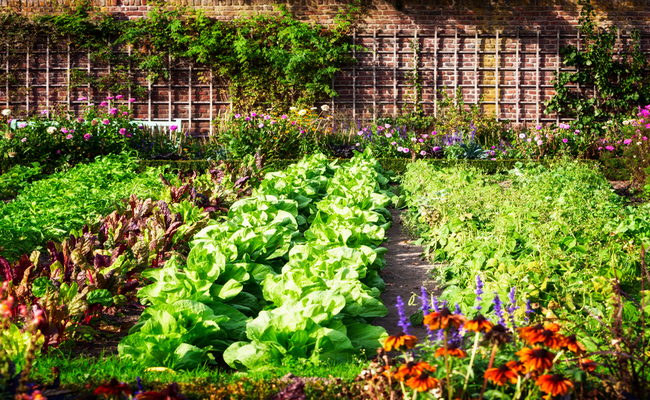Grow Your Own Salad Garden

There are more reasons than ever to grow your own salad. You are in control of its organic status and therefore reducing your exposure to toxic pesticides. You can ensure no genetically-modified organisms are ever planted. You can maximize the nutritional value by adding compost to enhance soil and eat the salad ingredients almost immediately after picking them (a significant amount of nutrition is lost within the first 24 hours of picking produce).
You can do your part for the planet by reducing greenhouse gas emissions in the growing and transportation of food. You can reduce the amount of money you give to greedy corporations who participate in unsustainable, land-depleting agricultural practices.
Honestly, these are just a handful of the reasons to grow your own salad garden. There are plenty of other reasons, including taste. Freshly-picked, homegrown food just tastes superior to its grocery store counterparts. So, where do you start? It’s easier and far more rewarding than you might think.
Grab some organic seeds and a garden bed or planter boxes or pots and a pair of gloves. Here are some of the best and easiest salad ingredients to grow:
LEAFY GREENS
Since no salad would truly be complete without some leafy greens, start by planting your favorites. You can select from a wide variety of greens. They’re all fairly easy to grow and you can get a relatively large harvest even from a small space. You can choose arugula for a peppery-tasting variety, spinach for a hearty green, kale to elevate your salad to superfood status, a spring mix for a variety of flavors, or butter lettuce or Romaine to have some classic varieties to choose from. They can all be sown indoors or be directly planted into garden spaces, pots or planters.
Spring is the ideal time to plant greens as they tend to grow best before the full heat of summer. You’ll want to spread the seeds out a bit (from 2” for spinach or 12” for arugula plants) unless you’re interested in growing baby greens. In that case, you can plant the seeds much closer together. Follow the package directions for the specific greens you choose. Most only need to be one-half inch deep, which means you can simply poke the soil with your finger and plant the seeds in the holes and then cover with soil. Once the leaves get started you’ll want to keep a spray bottle of water with a splash of natural liquid soap on hand to spray the leaves and keep pests away.
TOMATOES
If you’ve never eaten a home-grown tomato, you’re in for a real treat. They have a rich flavor and tend to lack the pulpy texture of many store-bought tomatoes. Unless you live in a climate with a fairly long growing season you’ll want to buy organic bedding plants if you want to grow your own tomatoes. Plant outdoors once the last overnight frost has passed. Plant them in a sunny spot and water regularly. Be sure to choose organic varieties as there are some genetically-modified varieties; however, since they are not required to be labelled it is hard to differentiate the GMO tomato plants from other varieties. So, it’s best to just be safe and choose organic bedding plants. Also, avoid non-organic varieties because they are often sprayed with toxic pesticides that kill bee populations and can have damaging health effects on humans and animals. You’ll want to stake the plants or use tomato cages as the plants get larger to help them stand upright.
HERBS
I love to keep an assortment of herb plants on hand to include directly in salads or to make delicious homemade herb salad dressings. For this purpose you can choose from basil, chives, cilantro, dill, green onions (technically a vegetable but used more like an herb), mint, oregano and rosemary (best in salad dressings). As far as I’m concerned, you really can’t have too many herbs on hand and the more varieties the better.
They tend to be mostly care-free and pests tend to leave them alone (although they might enjoy your basil or mint plants a bit more than the others). They are easiest to grow from organic bedding plants, which are often available from your local farmer’s markets this time of year. The herbs add a wonderful, unique flavor to your salads and dressings but also significantly kick up the nutritional and therapeutic value of your salads.
OTHER ADD-INS
Of course, there are many other foods you can grow to round out your salad garden. I love growing beets because I get the delicious beet greens and then can roast or grate fresh, raw beets into my salads. You can sow the seeds directly in the ground as they tend to be quite hardy and easy to grow. Carrots also make a nice appearance your salad garden since they can be grated and add a brilliant orange-color and a burst of beta carotene to your salads. Again, they can be sowed directly from seed into the ground and are quite easy to grow.
Radishes and cucumbers make excellent accompaniments for your salad garden. Sow radish seeds directly from seed or bedding plants. As for cucumbers, you’ll probably want to grow them from organic bedding plants and plant them in a slightly larger garden bed so they have some space to spread out. The amount of space they need differs depending on the variety but you’ll probably want to spread them at least a couple of feet apart to give them room to spread, which they need